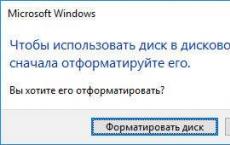Transferring Mac OS to a new ssd. Cloning a hard drive in Mac OS X. Long live the SSD
Changing a work or home computer is an inevitable process that happens every few years.
Apple developers have done everything possible to make data transfer as fast and convenient as possible.
Here are some simple steps you need to take to transfer data from your old Mac to your new one.
What are the requirements
In order to successfully transfer data from one Mac to another, you need to:
1. Computers must run OS X Snow Leopard 10.6.8 or a newer version of the system.
2. The computer from which the transfer is being carried out must be given a name ( System Preferences – Sharing – Computer Name).
3. Both computers must be connected to the network and a power source.
How to transfer data

1. If both Macs have OS X El Capitan or newer, it will be enough to connect both devices to the same Wi-Fi network.
Otherwise, the old Mac needs to be connected to the new one via FireWire, Thunderbolt or USB Type-C. Data transfer is possible using external hard drive mode.
2. Next, you should run the utility on the new computer Migration Assistant and select item . The utility is pre-installed and is included in every Mac out of the box.
3. On an old Mac, run the utility in the same way Migration Assistant and select the item On another Mac.
If the old Mac is connected in external disk mode, you don’t need to do anything on it; Migration Assistant on the new computer will automatically recognize the connected startup disk and offer to transfer data from it.
All that remains is to wait for the process to complete.
How to transfer data via Time Machine

When it is not possible to directly connect the old Mac to the new one or it is being sold before purchasing a second device, you can use the backup utility to transfer data.
1. On an older Mac, you should create a backup manually or automatically. The copy can be stored on a network drive or removable storage device.
2. On a new Mac you should run the utility Migration Assistant and select item From a Mac, from a Time Machine backup, or from a startup disk.

3. The next step is to select a copy from Time Machine and select the data you need to transfer. You can copy documents, applications, account information, and settings. The utility allows you not to copy any type of data.
If the new Mac already has an account with the same name, the system will ask you to rename it or replace it, overwriting the data from the old computer over the data on the new one.
After completing the transfer procedure, you will receive a familiar working environment with all the parameters, settings and programs.
Fair, not overpriced and not underestimated. There should be prices on the Service website. Necessarily! without asterisks, clear and detailed, where technically possible - as accurate and concise as possible.
If spare parts are available, up to 85% of complex repairs can be completed in 1-2 days. Modular repairs require much less time. The website shows the approximate duration of any repair.
Warranty and responsibility
A guarantee must be given for any repairs. Everything is described on the website and in the documents. The guarantee is self-confidence and respect for you. A 3-6 month warranty is good and sufficient. It is needed to check quality and hidden defects that cannot be detected immediately. You see honest and realistic terms (not 3 years), you can be sure that they will help you.
Half the success in Apple repair is the quality and reliability of spare parts, so a good service works directly with suppliers, there are always several reliable channels and your own warehouse with proven spare parts for current models, so you don’t have to waste extra time.
Free diagnostics
This is very important and has already become a rule of good manners for the service center. Diagnostics is the most difficult and important part of the repair, but you don't have to pay a penny for it, even if you don't repair the device based on its results.
Service repairs and delivery
A good service values your time, so it offers free delivery. And for the same reason, repairs are carried out only in the workshop of a service center: they can be done correctly and according to technology only in a prepared place.
Convenient schedule
If the Service works for you, and not for itself, then it is always open! absolutely. The schedule should be convenient to fit in before and after work. Good service works on weekends and holidays. We are waiting for you and working on your devices every day: 9:00 - 21:00
The reputation of professionals consists of several points
Company age and experience
Reliable and experienced service has been known for a long time.
If a company has been on the market for many years and has managed to establish itself as an expert, people turn to it, write about it, and recommend it. We know what we are talking about, since 98% of incoming devices in the service center are restored.
Other service centers trust us and refer complex cases to us.
How many masters in areas
If there are always several engineers waiting for you for each type of equipment, you can be sure:
1. there will be no queue (or it will be minimal) - your device will be taken care of right away.
2. you give your Macbook for repair to an expert in the field of Mac repairs. He knows all the secrets of these devices
Technical literacy
If you ask a question, a specialist should answer it as accurately as possible.
So that you can imagine what exactly you need.
They will try to solve the problem. In most cases, from the description you can understand what happened and how to fix the problem.
When it comes to upgrading your MacBook, iMac or Mac Mini, this article comes in handy. A new OS installation usually involves a lot of customization and installation of additional programs. In such cases, it is best to use disk partition copying and transfer OS X from HDD to SSD. We recommend using the Carbon Copy Cloner program to copy disk partitions under Mac OS X. The Carbon Cope Cloner program is very simple and straightforward. On the left is the source disk, on the right is the target disk, at the bottom is the Clone button, which will start the process of transferring information.
The left Source Disk list displays all disks mounted in the system: HDD, SSD, CD/DVD and flash drives. There will also be attached disk images in DMG format.

Disk images can be selected from the item list Restore from disk image... and find the corresponding file on the disk. An even more interesting point Remote Macintosh– it will allow you to copy a partition of a Mac connected via a local network. To do this, you need to know its network name or IP address. The right list offers almost the same possibilities: you can create a disk image from a source, restore the contents of the source to an existing image or to a Mac disk on the network.

A green circle means that the target disk will retain all boot properties of its source. Even more important is the check mark. Delete items that don’t exist on the source, on which behavior depends Carbon Copy Cloner in relation to files already existing on the target disk. If it is set, the target partition will be formatted and the information will be completely copied sector by sector. Otherwise, the matter will be limited to adding files from the source.
There are only 2 options in the drop-down list above this checkbox: Backup everything– the entire contents of the source disk are copied. Incremental backup of selected items– in this case, the left side of the window will turn into something like a Finder, and to the left of each folder and each file you will see checkboxes that will allow you to mark only those objects that need to be copied. All you have to do is click the Clone button, enter the password and wait until the OS X disk partition is copied and the data integrity is checked.
Good day everyone!
In this article I will talk about how I tried to “make friends” between MAC OS and Win XP on a single macmini and extend this union to 12 similar computer science class machines in a secondary specialized educational institution (college).
“But the song is not about that at all...”
To be honest, the article was conceived rather not to describe the technical side of the issue (because on this part on the Internet you can find everything in parts and put it together), but so that novice system administrators, computer scientists or computer science teachers in educational institutions, similar on me, found everything in one place, without being distracted from the educational process. Well, and once again highlight some problems in the field of IT in our educational institutions.Background
By education I am... a biologist. And although I have never worked in my specialty, this fact greatly influences my “career” and approach to performing my duties. Performing, by and large, the functions of an enikey, and amusing myself with the sweet thought that I am a “system administrator,” I work at a forestry college as a kind of “electronics engineer.” This is the bet.There are about 120 machines in the college, partially united in a peer-to-peer network (I hope that I will still raise the domain, but so far the matter has not gone beyond conversations about it and the verbal consent of the director, because it is very difficult to explain to various deputies, accountants and economists, why it is needed, but these are rather my problems, not theirs). There are 5 computer classes. One of these classes is equipped with macmini computers.
Before working in college, I had never seen a Macmini, never used a Mac OS, and only heard about Apple that it was “expensive”, “high quality” and “not enough in Russia”. But thank God I had some experience with linux. By that time, I had transferred my home PC and laptop to ubuntu, and rummaged around FreeNAS and Debian a little. And most importantly, after getting acquainted with linux, I COMPLETELY reconsidered my attitude towards Varez software, towards Microsoft’s policies and raising the younger generation in these conditions...
There is no sadder story in the world than deceived children...
I'll describe the class:3 new PCs with Varez 7 on i3/2GB/500GB, 1 old PC with Varez XP, and 13 macmini, on one of which
XP “beast edition” and an accidentally worn Mac partition, and on the 12 others in all its glory Windows Vista “business edition”, which was installed in parallel with MAC OS X “snow leopard” using bootcamp, but in fact is the only system on this computer. And although it seems to be licensed, after the update the activation “fails” (I didn’t go into detail here). At the same time, everything is infected with viruses, something constantly doesn’t work, kids break something (they tore out a button, for example, from a wonderful aluminum keyboard...), the once white boxes are covered with a layer of dirt... To my question, “and why not use licensed software from apple, instead of... mmm... THIS?”, I received the answer that “nothing is clear there,” “there is no Photoshop, office, mathcad” and so on and so forth.
Sadly? In my opinion, quite. And since these poppies were donated to the college as part of some program, no one has any idea how much it all costs and how many people dream about it (even though I’m not an Apple fan myself).
In general, I soon received the task so that “everything would work, not slow down, and everything would be the same everywhere.” And since I am not yet allowed to solve the problem globally (replace MS Office with open or libre, look for analogues for MAC OS of other software, preferably “open source”, since, of course, there is no money for a licensed one), I am reluctantly made the decision, using Perumov’s “principle of lesser evil,” to follow the path of Warez XP + MAC OS.
Implementation
1) The “reference” computer was configured. To do this I did the following:- Completely updated the “snow leopard” on one of the cars
- I completely demolished the whist partition (a step, in principle, not necessary, I just initially planned to install XP on a virtual machine “inside” the Mac)
- Using Boot camp Assistant, I created a partition for windows and installed Windows XP according to this manual
By the way, it says there that you need only the original disk with Win XP sp2 or older, and that different builds and multiboot disks a la “beast” will not work. It should be noted that, yes, at the very beginning, when the partition is first created using the wizard, Assistant simply “does not see” the multidisk, but although I have not checked, if you install the original first, then you can then replace it with any assembly . But, again, this is only guesses.
- Updated XP sp2 to the latest state, configured accounts, installed the necessary software
- Then the search began for something to clone all this onto other poppies. my mistake was that I was only looking for Mac utilities for this purpose. I spent a lot of time, but got no results. For example, Carbon copy cloner refused to write an image of a partition from XP to an external drive (apparently due to the fact that it had the NTFS file system), etc. And so, when I was completely desperate, I decided, just for fun, to try the good old Clonezilla. Why didn't I use it right away? Apparently, because I am a biologist by training... For some reason I thought that since this is not a real BIOS and this is a Mac OS, then... In general, Clonzilla did everything perfectly. Fast and neat.
- Well, all that remains is to change the NetBIOS names, IP and all that stuff
Conclusion
I must say that I was planning to do something about this for a very long time, I rummaged through Google, thinking about what and how. But I was hampered by some fear of an Apple product unknown to me. And solving the problem took only one day off, on which I decided to go to work for free. Once again I realized that in order to do something, you need to start doing it!I hope that this experience will serve biologists and system administrators like me.
P.S.
I hope that soon I will be able to change the situation in college. I plan to carry out some educational work with colleagues on the topic of open source software and piracy, introduce libre office and thunderbird instead of the Warez MS office and The Bat, reorganize the IT infrastructure of the college itself, and raise the domain. The electronic application system and portal with news, instructions, etc. are already in full swing. within the network.
Well, once again I express my deepest gratitude and respect to all open source software developers, and in particular, Clonezilla!
__________________________________________________________________________________________
Let us immediately note that the information will not be useful for owners of the most modern laptops, since, firstly, they come only with pre-installed solid-state drives, and secondly, the installed drives have an unconventional form factor and interface.
But for owners of laptops with a 2.5” form factor and a SATA interface, the presented instructions will help improve the performance of the laptop without significant costs.
You can, of course, ask for a replacement drive at an official Apple service center, but the service may turn out to be quite expensive, and besides, you will probably be offered some kind of Solit-State Drive Kit - “official, from the manufacturer,” the price of which, to put it mildly, is will not match performance.
We, in turn, invite you to replace the HDD with an excellent SSD yourself and are ready to provide.
In the photos below you can see the SanDisk SSD. It was this solid-state drive that ended up in our laboratory at the time of writing this article. This SSD instance is based on the SandForse SF-2281 controller, which has proven itself in other solid-state drives. They are distinguished by high read/write speeds and increased fault tolerance.
So what do we need?
This whole procedure will not take you even 30 minutes, but the performance of the laptop will increase quite seriously - the operating system and applications will load almost instantly and in general the laptop will “respond” to your requests much faster. This is because the system will have instant access to data, and this is exactly what is necessary to increase the speed of operation.
In addition, it does not make any sounds even when actively working with data, so your MacBook will become even quieter.
In addition, due to the significantly lower power consumption of SSDs, compared to any 2.5" HDD, the MacBook will be able to work slightly longer on a single battery charge - this is another undeniable advantage of using solid-state drives in laptops.
The only thing that yours will lose is a couple of grams of weight, because an SSD is also a little lighter than a hard drive.



